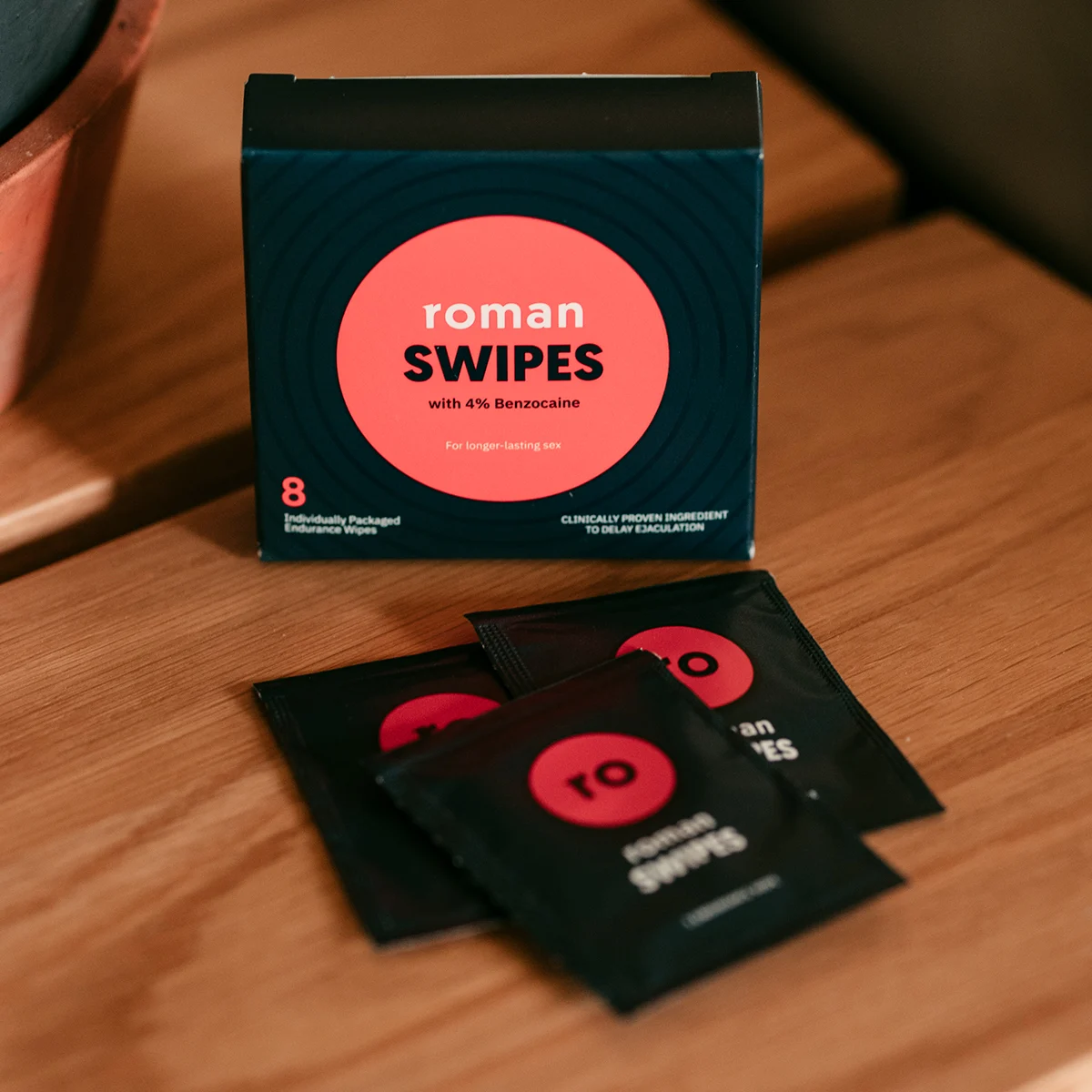Promescent spray for PE: how to use it, and does it work?

Reviewed by Chimene Richa, MD,
Written by Linnea Zielinski
last updated: Sep 15, 2021
5 min read
Here's what we'll cover
Despite most people's unwillingness to talk about it, premature ejaculation (also known as PE) is the most common male sexual dysfunction. You may have heard about Promescent spray as a potential treatment for PE. Read on to learn more about its use and effectiveness.
What is Promescent spray?
Promescent Delay Spray is an FDA-compliant over-the-counter aerosol spray that uses lidocaine as its active ingredient. Lidocaine sprays and creams are part of a group of PE treatments called desensitizing agents that can help lengthen the time between first sexual contact and ejaculation.
As you well know, the penis is one of the most sensitive organs in the body, and sensation is an important part of arousal and orgasm. But for people with PE, too much sensation can cause ejaculation to occur quicker than they’d like. Topical desensitizing sprays, like Promescent, work by decreasing penis sensation and delaying orgasm and ejaculation until you are ready (Sutton, 2018).
What is Promescent spray used for?
Promescent Delay Spray is used to treat premature ejaculation, one of the most common sexual dysfunctions. If you think you may have PE, you are not alone—approximately 30% of men worldwide experience PE (Crowdis, 2021).
Researchers generally consider premature ejaculation as orgasm and ejaculation just before or shortly after beginning sexual intercourse. While it may be tempting to define how long sex should last, there's no hard-and-fast rule. In reality, ejaculation is considered premature if it happens before you or your partner would like (Crowdis, 2021).
How to use Promescent spray
Promescent is easy to use. Just follow these simple instructions (Promescent, n.d.):
Spray the product directly onto the most sensitive parts of the penis—for most people, this is the frenulum (the area that connects the underside of the rounded end of the penis to the shaft), the underside of the shaft, and the head (glans) of the penis. You can adjust the number of sprays you need—use at least three, but no more than 10 sprays.
Rub the product into your skin, and be sure to wash your hands thoroughly afterward.
Apply the product about 10 minutes before you plan on engaging in sex. The spray works whether you are erect or not.
Promescent lasts up to one hour after application.
Effectiveness of Promescent spray
Although there aren’t many clinical studies specifically on Promescent, one study did find that the product positively improved the quality of sexual experience, lengthened the time it took to orgasm and increased the frequency of both partners having an orgasm. Participants reported that the product effectively delayed ejaculation, and the frequency of both partners reaching orgasm also increased from 44.1% to 65.6% when using this desensitizing spray. People in the study saw improvement even after using Promescent the first time (Mark, 2016).
Another study looked at the effectiveness of a 5% lidocaine spray (not Promescent) in people with PE. Researchers found that the spray improved PE symptoms, delayed ejaculation, and increased sexual intercourse frequency compared to the placebo group (Abu El-Hamd, 2020).
Benefits of Promescent spray
Lidocaine, the active ingredient in Promescent spray, may help your premature ejaculation by decreasing your penis sensitivity. But that’s not the only possible benefit.
Sprays like Promescent have benefits over lidocaine creams, another desensitizing treatment for PE. The spray is easy to apply and fast-acting—it can start working 2–4 times faster than topical creams. (Butcher, 2020). You only need to wait 10 minutes for Promescent to work.
Another benefit of Promescent is that, since the spray gets rubbed into the skin of the penis, you are less likely to transfer the product to your sexual partner (causing unexpected numbness).
Since topical desensitizing creams can be spread to another person, you usually need to thoroughly wash your penis or use a condom before intercourse (Butcher, 2020).
Lastly, Promescent's activity is limited to the area you spray—according to the company website, this is due to Promescent’s TargetZone technology (Promescent, n.d.). Unlike oral antidepressant pills or SSRIs (often used off-label to treat PE), it does not cause systemic side effects. While effective, SSRIs (selective serotonin reuptake inhibitors) can cause side effects like trouble sleeping, dry mouth, headaches, abdominal issues, and in rare cases, serotonin syndrome (Chu, 2021). You generally don’t have to worry about these adverse effects with Promescent.
Side effects of Promescent
While Promescent is less likely to cause side effects than some other PE treatments, it can cause local side effects like penis irritation, itching, and burning. If you or your partner experience these effects with Promescent, stop using the product and seek medical advice from your healthcare provider (DailyMed, 2021).
You may transfer some of the product to your partner during sex, whether vaginal, anal, or oral sex, although this is less common with Promescent than with lidocaine creams (Butcher, 2020).
You should not use Promescent if you are allergic to the medication or any of its ingredients.
One study found that Promescent has a toxic effect on sperm. It can decrease sperm motility, forward progression, and viability in laboratory studies. More research is needed to determine the clinical implications. Still, if you are trying to conceive, you may want to use caution or talk to your healthcare provider before using Promescent (Sutton, 2018).
How to last longer
Premature ejaculation is often due to a combination of physical, mental, and situational factors. Because of this, some people find that using multiple therapies helps them last longer in the bedroom.
Behavioral therapies
Promescent is just the beginning of therapeutic options available for people with premature ejaculation who want to last longer in bed. Behavioral therapies have been used for decades, but researchers have only shown limited long-term benefits to using them for PE. Though 45–65% of men report short-term benefits, 75% show no lasting improvement in prolonging sexual performance (Mark, 2016).
These behavioral strategies include a set of methods called edging. One example is the stop-start method (stopping sexual activity when ejaculation feels imminent and continuing after the feeling passes). Another is the squeeze technique, a variation on the stop-start strategy that includes the person or their partner squeezing the head of the penis to delay ejaculation (Raveendran, 2021).
Lidocaine sprays and creams
Climax control sprays and creams are readily available over-the-counter. Just as topically applied lidocaine desensitizes your gums at the dentist, it can do the same when applied to the most sensitive parts of the penis. Promescent is one example of a lidocaine-based spray, but far from the only option.
Fortacin is another topical anesthetic that uses a mixture of lidocaine and prilocaine to delay the time it takes to ejaculate. It uses a metered dose (each pump is a measured amount so that you can know how much of the product you're using) to ensure you apply the right amount (Porst, 2017).
Benzocaine topical products
Like lidocaine, topical benzocaine is also used to treat PE and is available in various forms.
You can find these sexual wellness products as sprays, gels, creams, lubes, and wipes (more on those below). Some products you may have seen in this category are K-Y Duration Gel and K-Y Duration Spray.
Premature ejaculation wipes
Benzocaine wipes are similar to other topical treatments, such as sprays and creams. Many use benzocaine as the active ingredient, which has numbing effects similar to lidocaine. These wipes are generally used on the most sensitive parts of the penis, including the frenulum, in anticipation of sexual activity. The product is typically applied about five minutes before sex and allowed to dry.
Desensitizing wipes show great promise for improving premature ejaculation. In one study, the average time to ejaculation doubled for participants after two months of using these wipes, though more research is needed to confirm preliminary findings. The participants also reported experiencing less distress about intercourse, more control over their orgasm, and greater satisfaction with their sex lives by the end of the study (Shabsigh, 2019).
Prescription treatments for PE
In some cases, prescription medication may be necessary to treat PE. Although there are no FDA-approved prescription medications available for PE, some providers prescribe certain medications off-label if they determine they’re the best treatment available for their patients.
Some studies have been done on using PDE5 inhibitors such as sildenafil (brand name Viagra), tadalafil (brand name Cialisnd vardenafil (brand name Levitra) to treat PE instead of erectile dysfunction, but more research is needed (Raveendran, 2021).
One class of antidepressants called selective serotonin reuptake inhibitors (SSRIs) has successfully treated premature ejaculation. In fact, the effects of delaying ejaculation can be seen within days of starting SSRI treatment, past studies have found (Mark, 2016).
Discuss all of your PE treatment options with a healthcare professional, who can provide additional information and make recommendations based on your individual circumstances and state of health.
Viagra Important Safety Information: Read more about serious warnings and safety info.
Cialis Important Safety Information: Read more about serious warnings and safety info.
DISCLAIMER
If you have any medical questions or concerns, please talk to your healthcare provider. The articles on Health Guide are underpinned by peer-reviewed research and information drawn from medical societies and governmental agencies. However, they are not a substitute for professional medical advice, diagnosis, or treatment.
Abu El-Hamd, M. (2020). Effectiveness and tolerability of lidocaine 5% spray in the treatment of lifelong premature ejaculation patients: a randomized single-blind placebo-controlled clinical trial. International Journal of Impotence Research 33, 96–101. doi: 10.1038/s41443-019-0225-9. Retrieved from https://www.nature.com/articles/s41443-019-0225-9
Butcher, M. J., Zubert, T., Christiansen, K., Carranza, A., Pawlicki, P., & Seibel, S. (2020). Topical agents for premature ejaculation: a review. Sexual Medicine Reviews, 8 (1), 92–99. doi: 10.1016/j.sxmr.2019.03.003. Retrieved from https://pubmed.ncbi.nlm.nih.gov/30987933/
Carson, C. & Gunn, K. (2006). Premature ejaculation: Definition and prevalence. International Journal of Impotence Research, 18 (S1), S5-S13. doi: 10.1038/sj.ijir.3901507. Retrieved from https://www.nature.com/articles/3901507
Carson, C. & Wyllie, M. (2010). Improved Ejaculatory Latency, Control and Sexual Satisfaction When PSD502 is Applied Topically in Men with Premature Ejaculation: Results of a Phase III, Double-Blind, Placebo-Controlled Study. The Journal of Sexual Medicine, 7 (9), 3179-3189. doi: 10.1111/j.1743-6109.2010.01913.x. Retrieved from https://pubmed.ncbi.nlm.nih.gov/20584124/
Chu, A. & Wadhwa, R. (2021). Selective serotonin reuptake inhibitors. [Updated May 10, 2021]. In: StatPearls [Internet]. Retrieved on Sep. 15, 2021 from https://www.ncbi.nlm.nih.gov/books/NBK554406/
Crowdis, M. & Nazir, S. (2021). Premature ejaculation. [Updated Jul 1, 2021]. In: StatPearls [Internet]. Retrieved on Sep. 15, 2021 from https://www.ncbi.nlm.nih.gov/books/NBK546701/
DailyMed. (2021). Promescent. Retrieved Sep 8, 2021 from https://dailymed.nlm.nih.gov/dailymed/fda/fdaDrugXsl.cfm?setid=5b508238-3be7-4b0d-bf35-51de79f58f55
Food and Drug Administration (FDA). (2019). CFR - Code of Federal Regulations Title 21. Retrieved Aug 26, 2020, from https://www.accessdata.fda.gov/scripts/cdrh/cfdocs/cfcfr/CFRSearch.cfm?CFRPart=348
Mark, K. P., & Kerner, I. (2016). Event-level impact of Promescent on quality of sexual experience in men with subjective premature ejaculation. International Journal of Impotence Research, 28 (6), 216-220. doi: 10.1038/ijir.2016.31. Retrieved from https://www.ncbi.nlm.nih.gov/pmc/articles/PMC5399162/
Promescent. (n.d.). Promescent: how to use. Retrieved on Sep 8, 2021 from https://www.promescent.com/pages/how-to-use
Raveendran, A. V. & Agarwal, A. (2021). Premature ejaculation - current concepts in the management: A narrative review. International Journal of Reproductive Biomedicine, 19 (1), 5–22. doi: 10.18502/ijrm.v19i1.8176. Retrieved from https://www.ncbi.nlm.nih.gov/pmc/articles/PMC7851481/
Shabsigh, R., Shabsigh, R., Kaminetsky, J., Kaminetsky, J., Yang, M., Yang, M., et al. (2017). Pd69-02 Double-blind, Randomized Controlled Trial Of Topical 4% Benzocaine Wipes For Management Of Premature Ejaculation: Interim Analysis. The Journal of Urology, 197 (4S), e1344-e1345. Retrieved from https://www.auajournals.org/doi/10.1016/j.juro.2017.02.3143
Sutton, M., Hunn, C., Summers-Colquitt, R. B., Chen, S. H., Kavoussi, S. K., Kavoussi, K. M., et al. (2018). Promescent has a cytotoxic impact on fresh human sperm in vitro. Urology, 114, 95–98. doi: 10.1016/j.urology.2017.12.027. Retrieved from https://pubmed.ncbi.nlm.nih.gov/29307732/









